


This summer The Index of Medieval Art welcomed two students from the Master of Information program at Rutgers University to inventory the Index’s photographic archive. Comprising nearly two hundred thousand cards in sixteen different medium categories, this historic image collection provides researchers a rich resource of sometimes rare visual references for the study of art produced throughout the Middle Ages. The inventories undertaken by Ryan Gerber and Michele Mesi have illuminated the extent of the archive and helped to assess the image and cataloguing needs for ongoing research and cataloguing at the Index. In this special two-part blog post, we are pleased to present their observations and accounts of their experiences.
It is a testament to the Index’s stimulating power that, despite my lack of an art-historical background, I found myself entranced by the system of cataloguing medieval iconography that the Index pioneered and is still practicing to this day. Its vision of greater accessibility through complete digitization represents another milestone in its long history, and one which will be a gift to scholars of all persuasions and experience levels.
A system largely developed by Index director Helen Woodruff in the 1930s, the photographic archive is organized in the first place by medium, then by location, object type, and the numeric order within that group. Unique codes on the left-hand corner of every index card in the catalogue represent each of these levels of organization. The fruits of this labor are hard to miss after spending any time with the Index and its elegantly interwoven subject index and photographic archive, where one can move seamlessly from subject description to pictorial representations and vice versa.
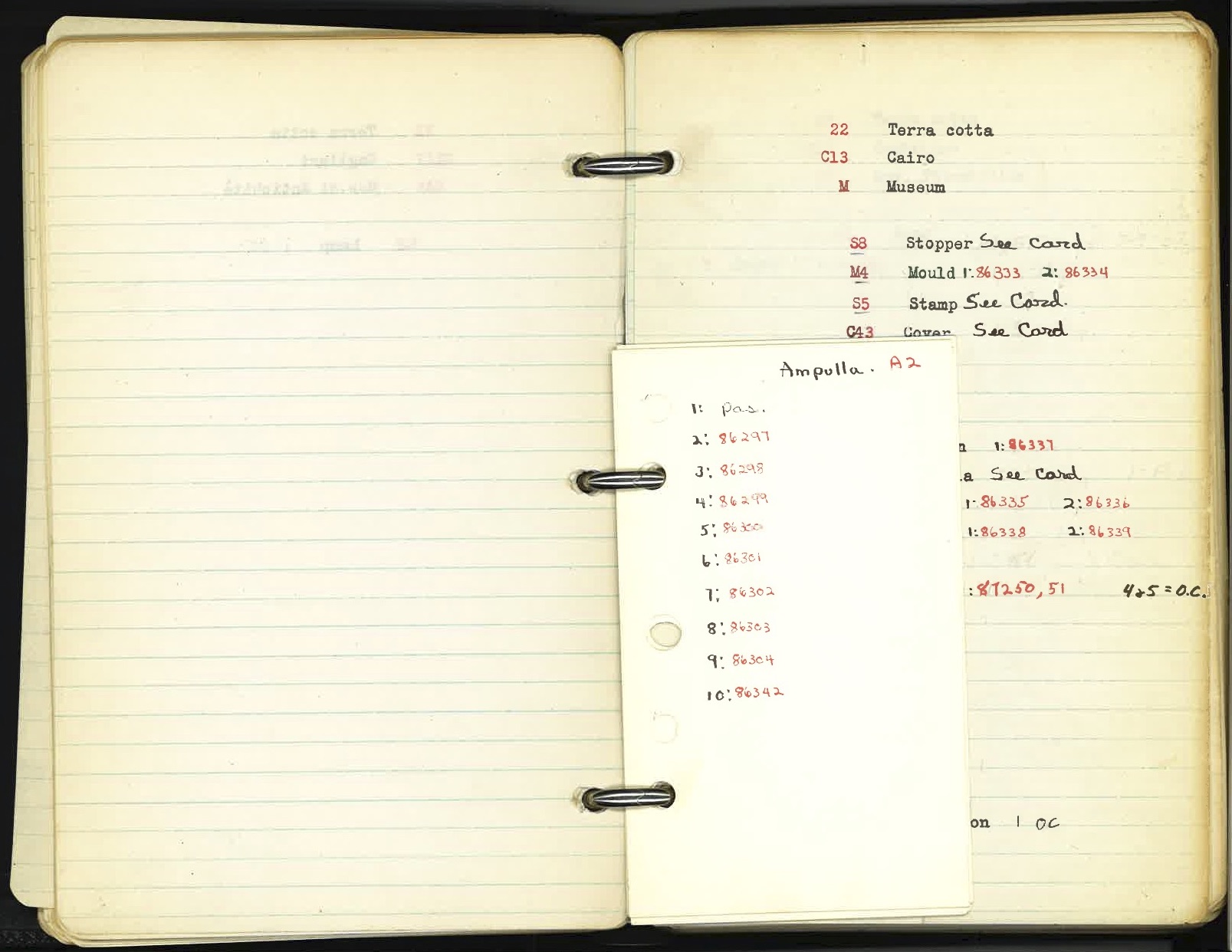
This work has also left behind a trove of archival resources such as hundreds of rolls of film and the so-called “Black Books” that were used to track the negative numbers. Each of the medium categories I inventoried not only laid the groundwork for further analysis of the collection as a whole, but highlighted the Index’s remarkable century-old ability to generate new curiosities and paths of inquiry.
Terracotta, Temporary Cards, Lamps, and Lions
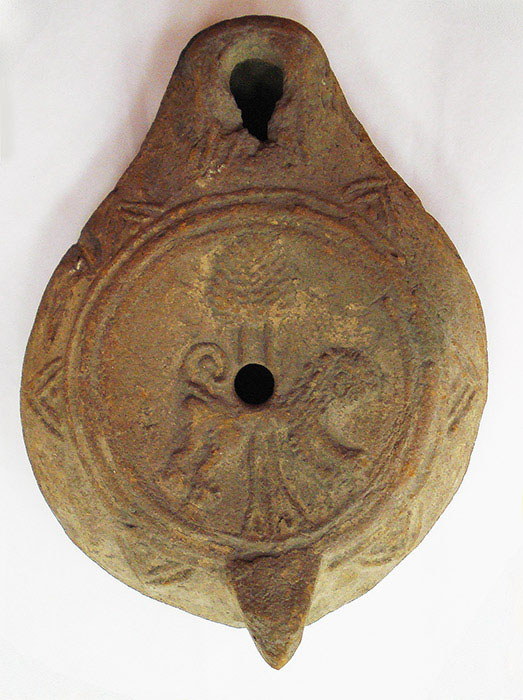
Under the medium “Terra Cotta”—a mixture of clay and water that is formed and baked or fired—the Index records more than twenty-five hundred objects across 196 locations. Of these objects, about sixty-five percent of them are oil lamps. The inventory of these files revealed some of the more common iconographic motifs found on terracotta objects, which include foliate ornament, a variety of land animals and birds, symbols such as crosses, as well as inscriptions and monograms. One terracotta lamp from the Benaki Museum in Athens depicts two of these popular motifs—a lion and a tree—combined on one impressed discus (Fig. 1).
Most photograph cards contain representations of the objects, but they also record the object’s location, the photograph’s negative numbers, subject headings for the image or images on the object, and some bibliographic information. However, there are many temporary “Orange Cards” in the archive that contain only a bibliographic reference and a subject term, and these still await corresponding images. Their inclusion in the original system nonetheless provides important data points about the objects they describe, laying the groundwork for future cataloguers to source the images for these object records. For example, the Index’s photo archive of terracotta objects in the National Museum at Carthage is mostly Orange Cards because the original Index records of these objects derive from a 19th-century publication with very few illustrations. While it would be useful to see images of the “lions” held at the National Museum in Carthage, even in the absence of photographs it may be just as useful to know that, of the 970 terracotta lamps held in that location, nearly four hundred depict animals, and about sixty-five of those include a lion.
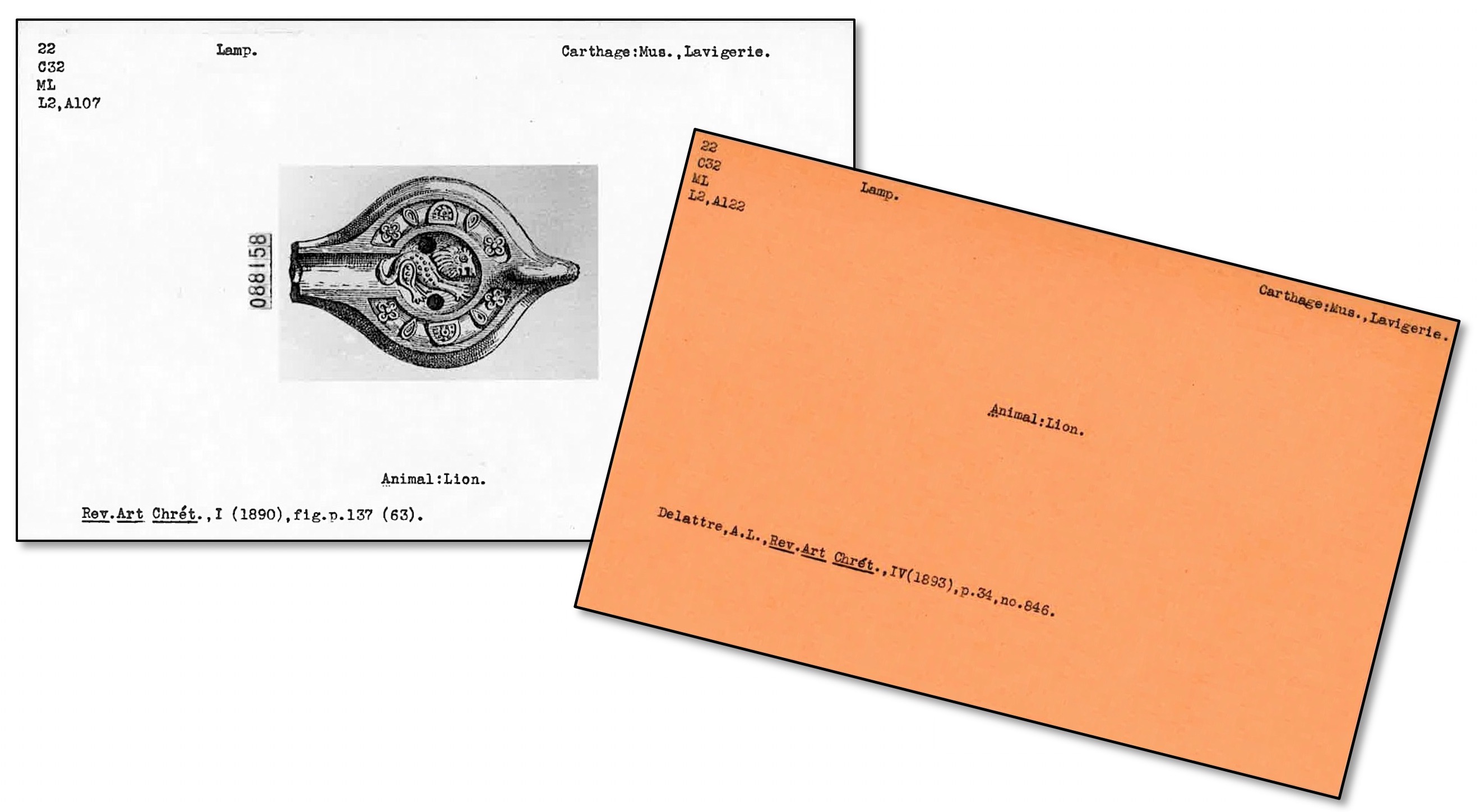
A Face in Gold Glass
The “Gold Glass” files record over 650 objects across sixty-three locations dating mostly from late antiquity between the 3rd and 7th centuries. Of these objects, nearly half are vessels of some kind. Gold glass developed as a medium in the ancient Roman and Hellenistic periods and consisted of decorative engravings made in gold leaf, which were then sandwiched between fused layers of glass. The result was lavish decoration, and exemplary pieces in this medium offer strikingly detailed portraits of their subjects, often depicting married pairs, family groups, or religious figures associated with one another, such as Saints Peter and Paul. Historians have noted the rarity of gold glass, as well as its costly, specialized method of production.[1]
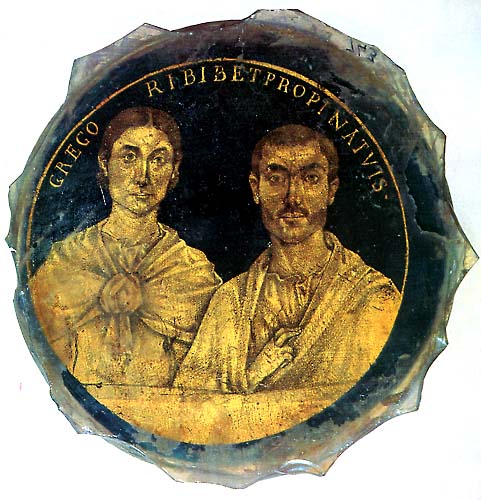
Gold glass was a special interest of Index founder Charles Rufus Morey, and his pioneering catalogue of the Vatican Library’s collections features as its first entry an example also catalogued by the Index. It shows the busts of a married couple inscribed above with the name Gregori and a Latin equivalent of “cheers!”: “Gregori bibe [e]t propina tuis,” or “Gregory, drink and drink to thine!” (Fig. 2).[2]

Another interesting discovery in the “Gold Glass” category was a round vessel fragment last recorded in the Cabinet des Médailles in Paris. It depicts a striking bust of a figure with shorn hair, dressed in a trimmed tunic, and with a distinctive crescent shape on their forehead. The only other information on the photograph card was the source of the image, the antiquities catalogue that Anne-Claude-Philippe de Caylus published in seven volumes from 1756 to 1767.[3] Caylus’s catalogue was a valuable starting point for identifying this figure, whose iconographic description had not been entered in the Index’s subject files or the database. A little more searching led to a color image in a French catalogue, the Histoire de l’art de la Verrerie dans l’Antiquité (Fig. 3), and to the conclusion that the inscription “SAPPO FLACILLAE”—with the genitive form of the empress’s name—referred to a branded enslaved person who had been freed by the Roman Empress Aelia Flacilla (356–386). We also used the photo-editing web application Pixlr to create a positive image of “Sappo” so that the image from the Index archive can now be seen as it appeared in the catalogue of the comte de Caylus (Fig. 4).
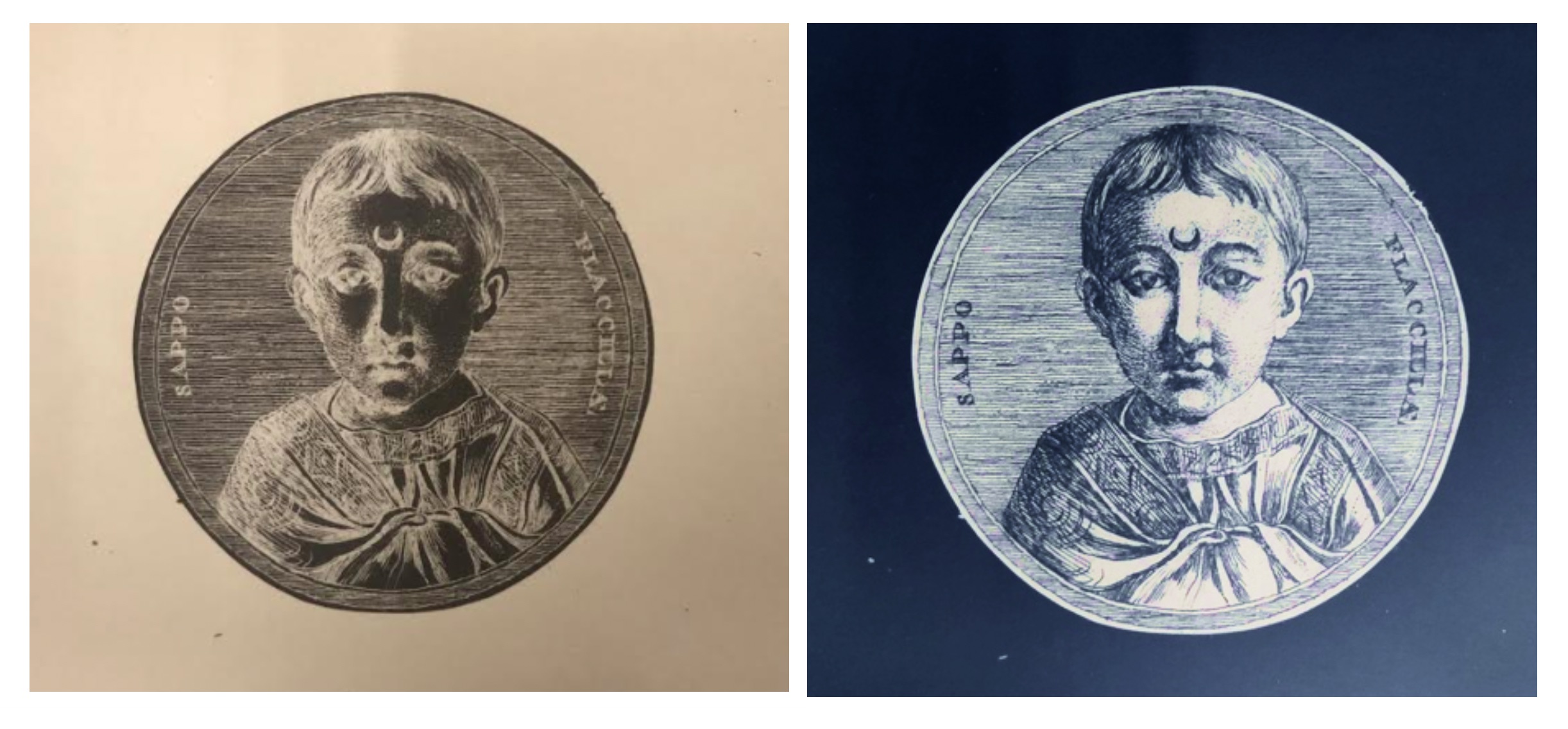
Impressions in Wax
Comprising a little over one thousand objects in 105 locations, the “Wax” medium files are overwhelmingly made up of stamps from Europe dating largely to the 13th and 14th centuries. Although the archive groups these objects into the single object category “Stamp,” the Index database divides them into two Work of Art Types, “Seal Matrix” (that is, the tool used to make the impression) and “Seal Impression” (that is, an impression made by a matrix).[4] Viewing about a thousand examples of Gothic seals intended for both religious and secular officialdom brought into literal relief the development of the production of seal dies from simple figural representations to complex ecclesiastical chapters in miniature, such as the Stamp of Ely Priory, dated to about 1240–1260 (Fig. 5). Other favored subjects in wax seals include heraldry, nobles, and popular saints and bishops, like Thomas Becket. The wealth of iconographic information in the “Wax” files—indeed throughout the archive—emphasizes that the Index is not a closed system, and has at every turn great potential for leading one into new areas of inquiry.

Ryan Gerber is a graduate student at Rutgers University studying Information Science with a concentration in Archives and Preservation. He holds an MA in English from The College of New Jersey with a concentration in Medieval and Early Modern Literature. His interests include digital preservation and retrieval, the digital humanities, and information behavior.
See Part 2 written by Michele Mesi.
[1] Giulia Cesarin, “Gold-Glasses: From their Origin to Late Antiquity in the Mediterranean,” in Things that Travelled: Mediterranean Glass in the First Millennium AD (London: UCL Press, 2018), 22–45.
[2] Morey noted of the inscription that “the E of ‘bibe’ or of ‘et’ [was] omitted by mistake.” Charles Rufus Morey, The Gold-Glass Collection of the Vatican Library (Vatican City: Biblioteca Apostolica Vaticana, 1959), 1. Translation after Georg Daltrop in Leonard von Matt, Georg Daltrop, and Adriano Prandi, Art Treasures of the Vatican Library (New York: Abrams, [1970]), 168.
[3] Anne-Claude-Philippe de Caylus, Recueil d’antiquités égyptiennes, étrusques, greques, romaines et gauloises (Paris, 1756–57), 193–205, pl. 53.2, https://archive.org/details/recueildantiquit03cayl/page/n10.
[4] See the Index database Work of Art Type browse list to access these Work of Art References.

Precious Gems Containing a Wealth of Iconography

“Glyptic” is among the smaller medium categories in the Index archive, filling only one drawer with a little more than eleven hundred cards that record only about nine hundred objects. The term “glyptics” refers the art of carving gems or seals—whether in intaglio or in relief—typically in gems or precious stones such as jasper, agate, carnelian, and amethyst.[1] This form of art is one of the oldest—known since the Mesopotamian, Egyptian, and Assyrian civilizations—but it was not until the Hellenistic period that relief cameos, seals, and more intricate glyptic objects began to appear.[2]
Glyptics, which were often worn as jewelry or incorporated into ecclesiastical objects, are recorded in the Index primarily as gems, amulets, plaques, rings, and stamps, and the largest category, cameos, which makes up nearly a third of the glyptic objects in the Index files. A significant portion of the subjects on these carved gems include animals and plant life, like doves, dolphins, fish, palm trees, and fantastic creatures. There are other symbols as well, such as the anchor, which appears on over forty examples. A significant number of glyptics incorporate classical and mythological figures, such as Orpheus, Diana, Jupiter, and Hecate. Nearly twenty cards for gem objects record the Gnostic figure Abrasax (Fig. 1). Glyptics such as these were powerful talismans for their owners.
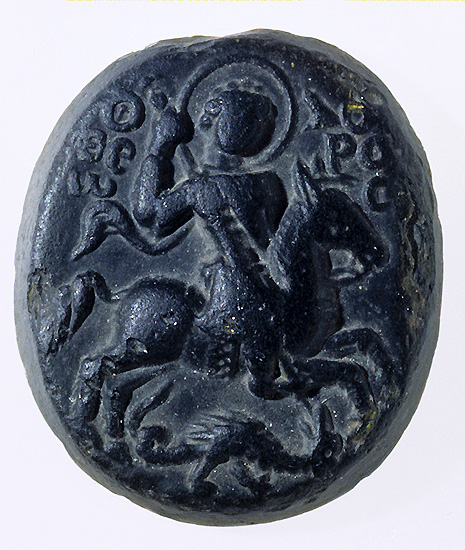
The traditional use of spiritual amulets was also adopted by Christians using Christian symbols and themes.[3] Christian iconography on glyptics include the triumphant Archangel Michael or Saint George, Daniel in the Lion’s Den, and the Good Shepherd. One cameo of opaque black glass made in the 13th century depicts Saint Theodore transfixing the dragon and well represents the preference for saintly imagery on later cameos (Fig. 2).[4] The inventory also revealed that there were nearly thirty examples of incised depictions of monograms on glyptics with a third of them being the Chi-Rho, a symbol for Christ consisting of the first two letters of the word “Christos” (Christ) in Greek.
The major collections represented in this medium include the Staatliche Museen in Berlin (over eighty objects) and the British Museum in London (nearly 125 objects. However, a large number of glyptics (over 140 objects) are recorded as “Location Unknown,” these items having been entered into the Index from major publications that did not provide the precise location at the time of publication.
Radiant Ivories for Both Secular and Religious Narratives

With nearly forty-seven hundred cards covering a little over thirty-one hundred objects, Ivory represented a more extensive category in this inventory project. The types of ivory objects recorded by the Index range from plaques, chess pieces, croziers, and triptychs to the more unusual oliphant (or hunter’s horn) to the handles of various utensils, and even a saddle. Some of the major collections represented in this medium are the Musée du Louvre and the Musée de Cluny in Paris, and the British Museum and the Victoria and Albert Museum in London. Ivory objects were expertly carved in minute detail, usually from the tusks of elephants. In the Index database, ivory acts as a “parent medium,” an umbrella covering such materials as bone, walrus tusks, and antlers.[5]
Various motifs of courtly love were often depicted on ivory caskets, plaques, mirror cases, combs, and other fine domestic objects.[6] A preference for secular subjects on ivories emerged in the twelfth century when an influx of secular imagery was brought to Europe from the Middle East after the Crusades, as well as through a rise in vernacular literature, legends, and romances.[7] Entertaining stories such as the tale of the Virgin and the Unicorn provided plenty of thematic material to adorn precious ivory objects. They often offered a double meaning or moral lesson, as in the story of Tristan and Isolde depicted on an early 14th-century ivory casket now in the Metropolitan Museum of Art, which warns against temptations of lust (Fig. 3).[8]
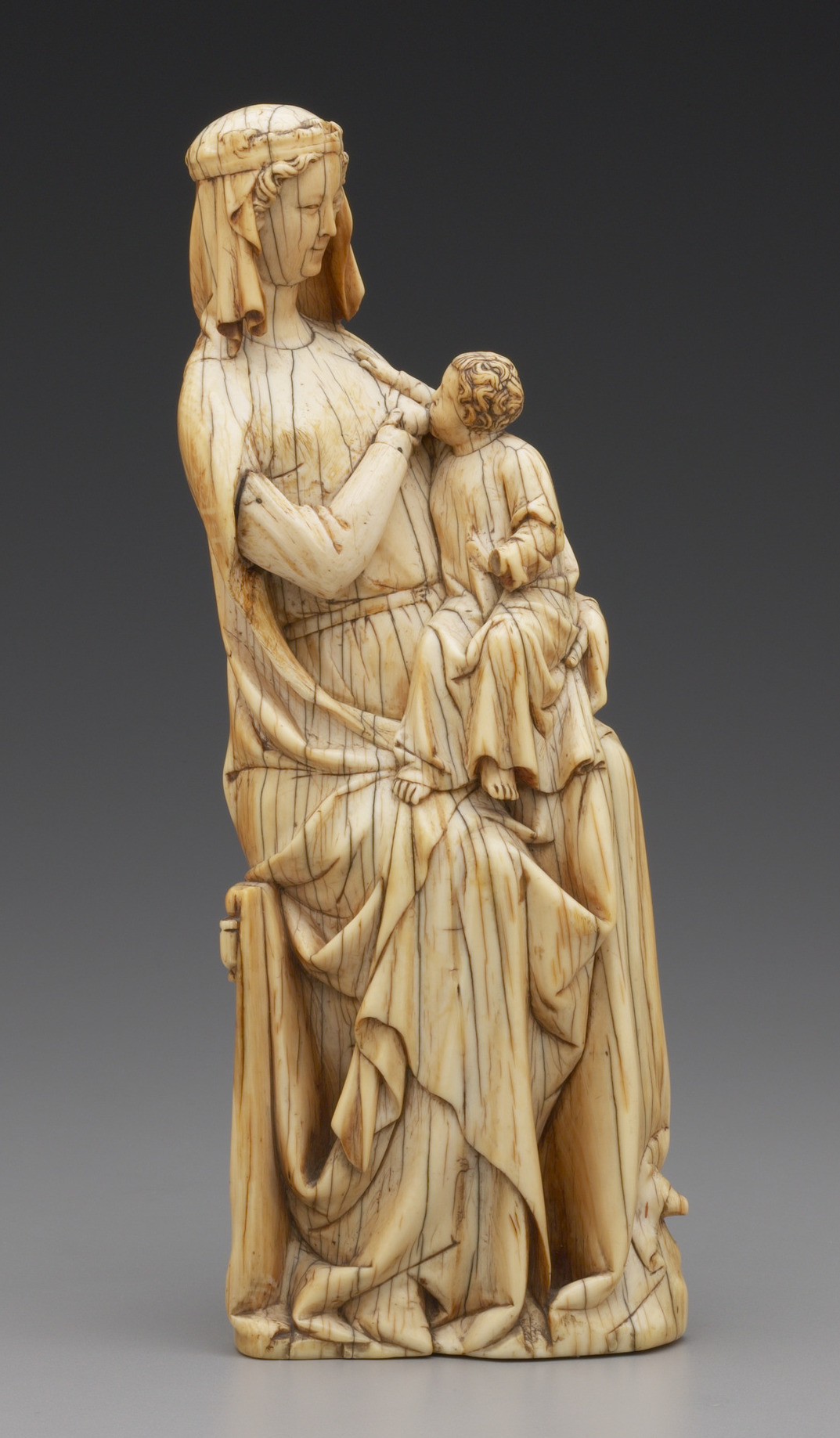
Despite their popularity, secular ivories are fewer in number than devotional works of art in ivory. Roughly a quarter of the ivory objects recorded in the Index are representations of the Virgin Mary and the Christ Child. This figure rises to more three quarters when we add individual figures of Christ or the Virgin Mary. One type seen rather frequently is that of the Virgin nursing the infant Christ—known in Latin as the Virgo Lactans—which the Index categorizes among the many “types” of the Virgin Mary and Christ Child. In the database, the subject heading Virgin Mary and Christ Child, Suckling Type is attached to over 290 Work of Art records. More than forty of these are ivory. This Virgo Lactans iconographic type is exemplified by a 14th-century ivory statuette in the Yale University Art Gallery, which displays an intimate and lifelike relationship between mother and child (Fig. 4). Thus, the devotional message is made personal.
The Project Continues …
Encompassing eight drawers of roughly one thousand cards each, “Painting” proved to be an abundant medium, but “Illuminated Manuscript” is by far the largest medium category in the Index, filling fifty-six of the photograph drawers. Medieval art objects encountered in these two categories range from painted icons and altarpieces to a wide variety of liturgical manuscripts and other illuminated books numbering perhaps in the thousands. The inventory of these and other remaining categories—including those comprising in situ works of monumental art, such as “Mosaic” and “Fresco”—will continue after this summer.
As a “living archive” that covers more than a millennium of artistic creation, the Index of Medieval Art has always been improved and expanded by the interactions of the cataloguers who create it with the with researchers who use it. Creating these inventories has been an illuminating way to participate in that process and to learn more about the contents of the Index card catalogue being prepared for entry into the online database. This project was challenging at times, due to the sheer breadth of the paper files, but it has been an invaluable undertaking for the ongoing process of research and digitization, and will improve accessibility to the records contained in this century-old archive of medieval art.
Michele Mesi is a graduate student at Rutgers University studying Information Science with a concentration in Archives and Preservation. From Rutgers University, she also holds a Bachelor’s degree in English with studies in Art History and in Digital Communication, Information, and Media. Her interests include art conservation, archival processing, and working with rare books and manuscripts.
See Part 1 written by Ryan Gerber.
[1] The Index of Medieval Art follows the standards for material description established by the Getty Art & Architecture Thesaurus (AAT). See the Art & Architecture Thesaurus® Online, https://www.getty.edu/research/tools/vocabularies/aat/.
[2] O. Neverov and A. Durandin, Antique Intaglios in the Hermitage Collection (Leningrad: Aurora Art Publishers, 1976), 7.
[3] Neverov and Durandin, Antique Intaglios, 8.
[4] The Index records the iconography in question as Theodore Tyro or Theodore the General, Slaying Dragon.
[5] See the glossary entry on the Index database Medium browse list for “ivory.”
[6] J. Lowden and J. Cherry, Medieval Ivories and Works of Art: The Thomson Collection at the Art Gallery of Ontario (Art Gallery of Ontario, 2008), 122.
[7] R. H. Randall, “Popular Romances Carved in Ivory,” in Images in Ivory: Precious Objects of the Gothic Age (Detroit Institute of the Arts, 1997), 63.
[8] Randall, “Popular Romances,” 67–68.
One of the little thrills those us who do academic research get to enjoy — whether we specialize in the arts and humanities or engineering and sciences — is when our favorite topics come up in films or on television. Imagine the excitement for anyone who studies Andalusian architecture when the quasi-medieval show “Game of Thrones” received rare permission to film inside the beautiful Alhambra Palace in Granada, Spain.

Now perhaps it will come as no surprise that several of us here at the Index of Medieval Art are looking forward to the next series of “Doctor Who” — and the premiere of the first female Doctor (to be played by Jodie Whittaker)! — when the Doctor’s complicated history with historical accuracy resumes. For those of you regrettably unfamiliar with “Doctor Who,” it is a long-running BBC show about a long-lived, possibly immortal, time-traveling alien, and history nerds are among the most avid Whovians. To understand why, just watch the episode in which Pompeii was destroyed because aliens were building a spaceship in Vesuvius! In another episode, we learned that William Shakespeare’s plays include secret spells that open portals to other parts of the universe!
In the most recent series, the episode “The Eaters of Light” took place in Scotland in the second century AD. The Ninth Roman Legion, charged with the task of defeating the “barbarians” living in ancient Scotland, disappeared without a trace. When the Doctor and his companions investigate, things get a little strange. In the second century, the Roman Empire was trying desperately to maintain control of the lands of the “Picts” who lived north of what would very soon be the site of Hadrian’s Wall. The Picts are so called because these “painted people” (Picti) are mentioned in very early medieval texts. We know almost nothing about them, other than that they were fierce warriors, they painted their bodies before battle, and they left behind large stone monuments decorated with pictographic writing.
The Index of Medieval Art has almost 250 entries for “Pictish” artwork, most of which are large stones, either stelai or crosses. The stones usually appear in pairs, and the symbols carved on them depict inanimate objects like mirrors and combs, or crescents, and other geometrical shapes, as well as animals such as horses, dogs, birds and the enigmatic “Pictish beast.” It was this Pictish beast, a creature something like a hybrid of dolphin, horse, and dragon, or even (as some have argued), the Loch Ness Monster, that was the focus of “The Eaters of Light.” The episode proposed that it was a species of lizard-like alien monster that traveled through a great stone chamber-tomb in northern Scotland. Released in order to defeat the invading imperial army, it continued eating, threatening to consume all the light in our universe. Of course!
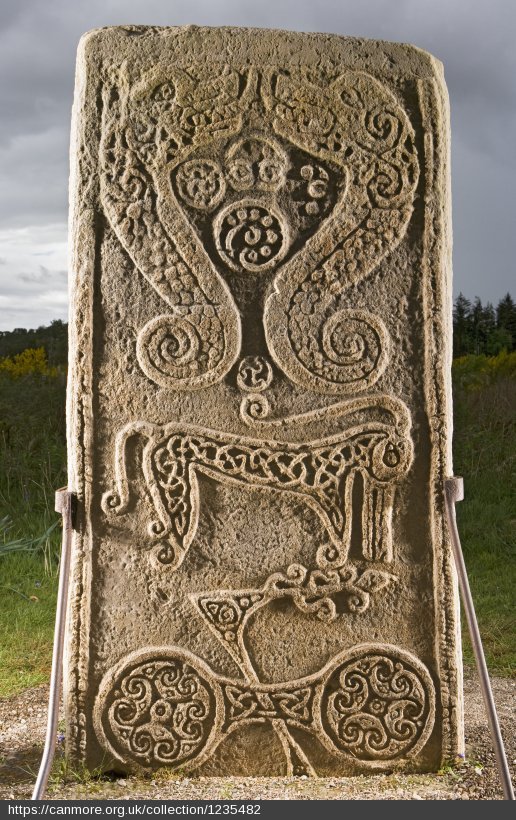
While this episode provides a fanciful interpretation of the Pictish stone carvings, it does actually highlight a point that art historians and archaeologists have been puzzling over for more than a century — just what do these symbols mean?
The stones were classified in the early twentieth century into three types, based upon their iconography and the level of detail in their carving. Class I stones, which date roughly to the fifth to seventh centuries, are relatively plain, and have only Pictish symbols inscribed upon them. Class II stones are slightly more ornate, with more effort obviously spent on not only carving the imagery but also on decorating the shape of the stone itself. They have not only Pictish symbols, but also Christian iconography such as very simple cruciform carvings. These are thought to date to the period of the seventh to ninth centuries, when conversion to Christianity was becoming more common in the region we now know as Scotland. Finally, Class III stones, which date to the later eighth and ninth centuries, are the most ornate. Their edges are highly decorated, the shape itself has been clearly hewn from the rock rather than simply incised upon it, and they have intricate carvings of knot-work and lace-work. Apparently used not only as upright markers or crosses but also as grave slabs, all of these Class III stones have explicitly Christian imagery, with many carved in the shape of crosses. None of them bear Pictish symbols, so these stones are interpreted as a last step in the Christianization of Scotland.
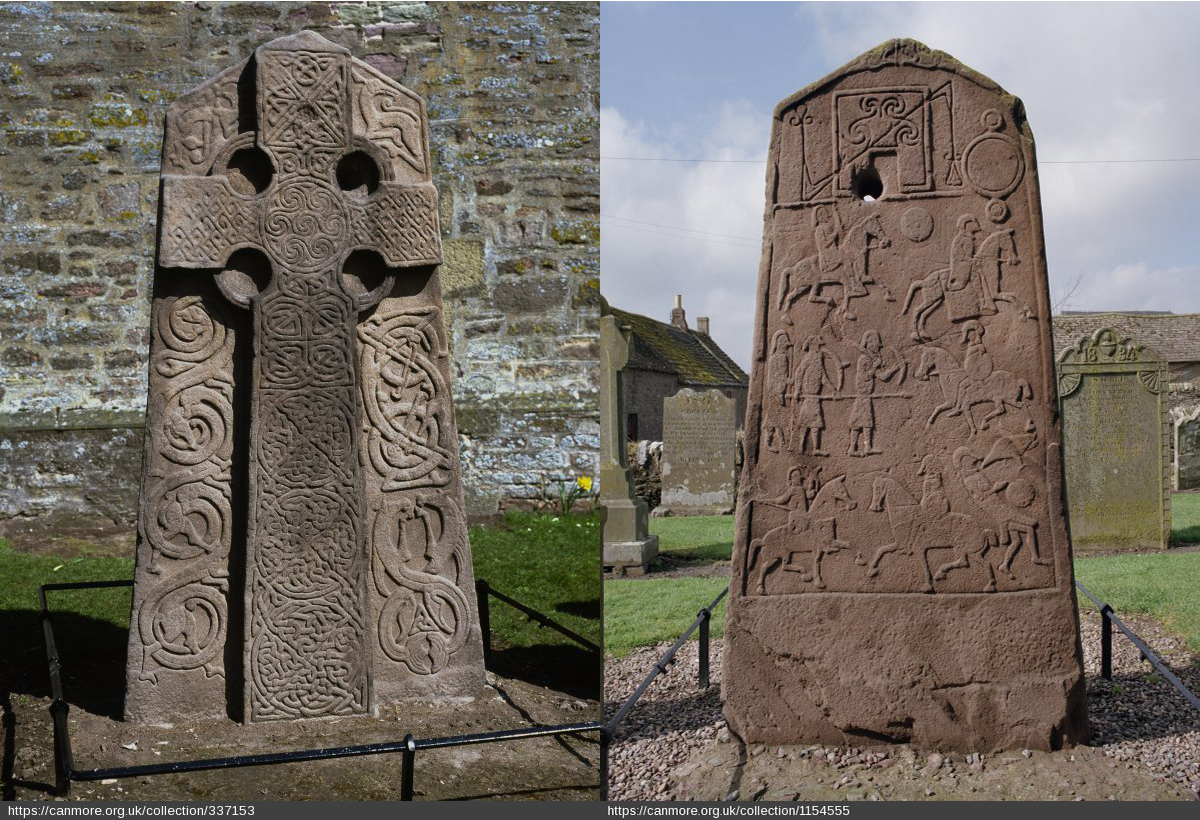
There are, however, two main difficulties in interpreting these Pictish symbol stones, though there are many theories as to what they represent. First, we are not entirely sure what they were for. Scholars have debated the issue for the last half century, arguing that they were monuments marking important meeting places or boundaries, or that they were memorials to particular individuals, families, events, or even that they might have been political statements opposing the spread of Christianity in early medieval Britain. Inscriptions are not helpful for interpretation either. While ogham writing in Ireland and Wales is found on stones that include Latin inscriptions, so that each stone is like a Rosetta Stone (with the Latin inscription in each case serving as a key to interpreting the ogham text), we do not currently have such a direct method of interpreting Pictish ideograms.
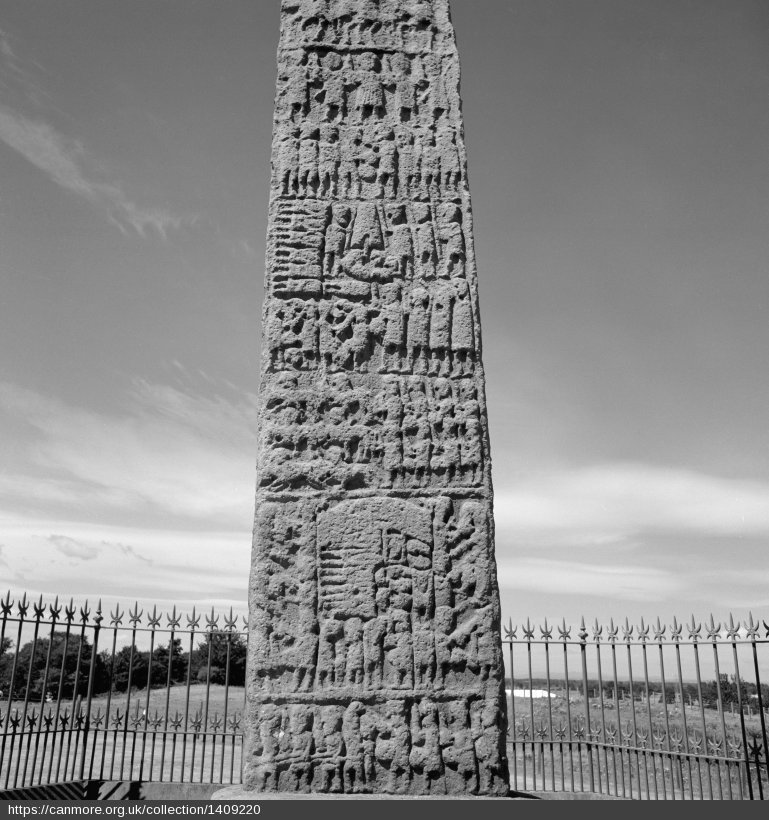
The second problem is the dating. Surviving Pictish stones suggest a development from the simple, presumably pagan, Pictish animals and shapes of Class I stones to the elaborate crosses in Class III. Like much archaeological evidence from the post-Roman fifth and early-sixth centuries in Britain, this dating is often based upon our expectations affected by early medieval texts like Bede’s Ecclesiastical History or Gildas’s On the Ruin of Britain, none of which were written in Britain in the period they describe. Unlike human or plant remains, stones cannot be radiocarbon dated. Even if we wanted to make the attempt at dating, for example, organic elements of the soil beneath the stones, only a few of the stones are actually still in situ. So the dating of the Pictish stones depends on parallels in manuscripts such as the Book of Durrow, and upon what we currently think about the history of the arrival of Christianity in Scotland. Even if we were able to determine with absolute certainty when exactly these stones were first inscribed and placed in the landscape, that account would still not consider the many succeeding generations and their many possible uses for these stones.
The Pictish stones in the Index of Medieval Art, especially the Class I stones, are part of a wider discussion of very early medieval society in Scotland. The Picts are the people that sixth-century and later texts blame for the beginning of the end of Roman Britain. Their raids along coasts to the south created defensive problems at a time when the Roman military presence in Britain was declining. Over the last fifty years or so, archaeological excavations of cemeteries in Scotland have increased our understanding of the monumental commemorations of death among the people who raised these decorated stones and crosses. The iconography on the stones that these people left behind is one of the few sources that modern scholars can work with to learn about the Picts and their world — and it also turns out to be a great source of inspiration for science fiction television.
This guest blog post was written by Janet Kay, a CLSA-Cotsen postdoctoral fellow at the Princeton Society of Fellows. She studies the history of fifth-century Britain, looking at burial practices to study a period for which there are no surviving texts. Janet uses material culture and funerary rites as primary sources to explore how fifth-century communities understood themselves and their newly-arrived neighbors from the continent and how invested they were in maintaining connections with their Roman past.